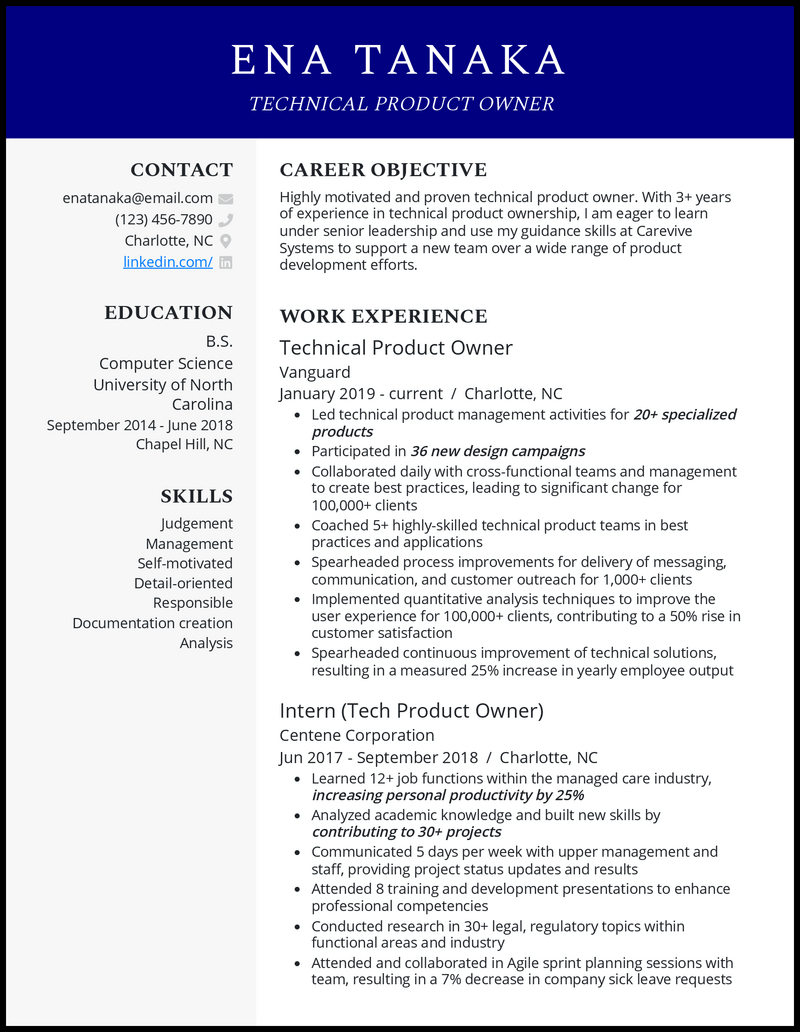The technical aspects of product development are where you shine. When you’re on the job, POC requests are made, documents are delivered, and Scrum processes are implemented effectively to improve workflows.
Have you refined the technical aspects of your resume to succeed in the hiring process? And what about writing a great cover letter?
When you have such a depth of specialized skills to cover, putting together an expert-level resume can feel daunting. Our technical product owner resume examples will have you covered, so you can use them as effective templates for success in the process.
What Matters Most: Your Technical Product Owner Skills & Work Experience

Organizations will want to bring you on board due to your technical skill set in aspects like agile methodologies and backend management. However, you do a lot on the job, so narrowing it down to just 6 to 10 skills for a resume may feel like a tough task.
Typically, the job description will help you focus on what’s most important. Does the organization need help with regular system maintenance? Then your skills in product testing architectures and technical backlog management would be great to include.
Here are some of the top technical product owner skills in 2025 to help you get started.
9 top technical product owner skills
- Scrum
- Agile Methodology
- Waterfall Methodology
- JIRA
- UX Improvement
- Backend Management
- ETL Data Development
- Data Warehousing
- Product Roadmaps
Sample technical product owner work experience bullet points
You’ve wowed the hiring team with your top skills in scrum methodologies and UX. However, they’ll still be looking for more data to see how you apply your technical skill set.
Every product development decision is backed by tons of data. That means you should have a leg up when it comes to providing quantifiable examples of your past achievements. Think in terms of process efficiency metrics or user experience scores.
Also, remember not to get overly technical with the examples you provide. Keep them simple so hiring managers can easily identify the top skills like backend management or data warehousing that they’re looking for on resumes.
Here are a few samples:
- Reviewed feedback from over 1,600 customers to make UX adjustments that improved satisfaction scores by 45%.
- Used JIRA to streamline workflows for 16 product departments, reducing production costs by $358,000.
- Identified and fixed issues with parallel processes, increasing network resilience by 86%.
- Led an 11-person team in creating a roadmap for new product development projects, which generated $5.3 million in new revenue.
Top 5 Tips for Your Technical Product Owner Resume
- Reverse chronological formatting is the best fit
- Development processes and technological needs are always changing. Therefore, optimize your resume by listing your most recent experiences first in aspects like agile scrum and ETL data development.
- Limit your resume to three or four jobs
- To avoid your resume getting bogged down with too many details, limit it to three or four highly relevant jobs. These should be the most recent ones and most relevant to the position’s needs, such as focusing on UX improvement if that’s a big need for the company.
- Action words are the most impactful
- An optimized resume will use action words like “built” and “reviewed” in examples to provide the most impact. For instance, you could say you “built 50 new data warehousing systems to speed up processes by 58%.”
- Technical skills should be emphasized
- Your role is highly technical, which should be emphasized in your listed skills. For instance, citing your ability to implement waterfall methodologies sounds much better than just listing project planning.
- Measure the impact
- Whenever you list achievements, try to quantify the impact they had by referencing numerical data. For instance, you could cite the revenue generated or a reduction in error rates.
Aim for a concise and highly-relevant one-page resume. To narrow down what you include, tailor everything to the position’s needs. For instance, if the company needs help with data management, your data warehousing abilities would be great to emphasize.
A resume summary will work well if you have ten or more years of experience. It could include a few sentences about how you’ve designed 175 product roadmaps that generated $5.5 million in revenue over your 12-year career.
Your cover letter can get a bit more personal and include more details about your on-the-job abilities. For instance, you can connect your passion to the projects the company is working on or write more information about how you use agile methodologies to improve workflows.








